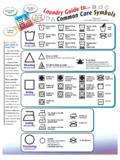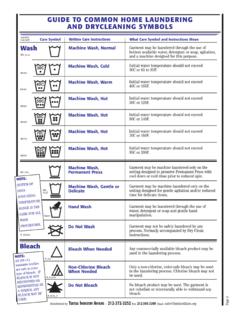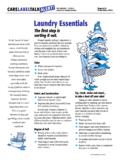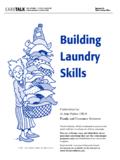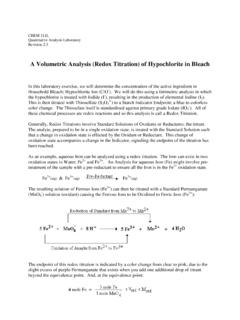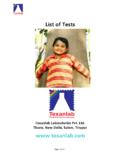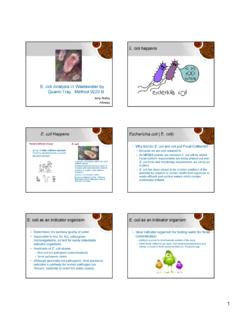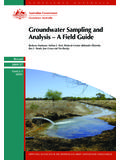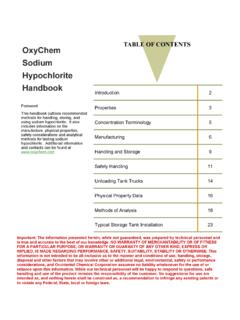Transcription of T I A ALTERNATIVE PROCEDURES FOR TESTING …
1 TEXTILEINDUSTRYAFFAIRSSOLUTION:Undiluted Liquid Clorox 2 .PROCEDURE:(1)Place a drop of Clorox 2 on the colors to be you are TESTING a garment, apply solution to a hidden part (inside seam, hemline or cuff). Be sure to test all colors and any decorative trim or if necessary to ensure penetration. (2) Let the sample stand for one minute. (3) Rinse thoroughly and let the dampened area dry completely. EVALUATION:Visually evaluate the test area(s). If there is no color change, or ifthe amount of color change is acceptable, the bleach care instruction should be Non-Chlorine Bleach When Needed , orwords to that effect, Only Non-Chlorine Bleach.
2 An instruction Do Not Chlorine Bleach is not acceptable under the Rule becausealthough it warns against chlorine bleach, it does not inform that non-chlorinebleach is performing evaluations the most accurate instruction will result fromcomparing the tested sample to one laundered in detergent alone. This will ensurethat the observed color change is attributable only to the bleach. The AATCC procedure for TESTING for colorfastness to laundering in detergent is AATCC 61 : Combine one part Clorox Ultra Liquid Bleach with five parts waterPROCEDURE:(1) Apply one drop of solution and allow it to saturate the you are TESTING a garment, apply solution to a hidden part (inside seam, hemline or cuff).
3 Be sure to test all colors and any decorative trim or if necessary to ensure penetration. (2) Let the sample stand for one minute, then rinse and blot dry.(3) Visually evaluate for color change. EVALUATION: If there is no color change, or if the amount of change is acceptable,the bleach care instruction should be Bleach When Needed .Colorfastness is not usually an issue with white fabric, but all white fabric known to have a chemical finish should be tested for potential yellowing byinteraction with chlorine bleach. This bleach test can also be used as a screeningfor white PROCEDURES FORTESTING TEXTILE COLORFASTNESS TO CHLORINEAND NON-CHLORINE (COLOR-SAFE) on backThe appropriate protocol for testingcolorfastness to chlorine bleach isAATCC 61-5A and 188.
4 Thisprocedure approximatescolorfastness results after fivewash/dry cycles in the presence ofdetergent and chlorine very reliable, this procedureis time, labor and widely accepted reliablealternative to 5A is a one-minutespot test that simulates five homelaunderings. This test has beenshown to be 95+% reliable and in nocase gives false that prove unacceptable forlaundering in chlorine bleach mustbe tested for colorfastness to non-chlorine bleach. The care-labeling rule is very specific. If agarment is safe in non-chlorine(color-safe) bleach, but not inchlorine bleach the label must say Non-chlorine Beach When Needed ,or words to that effect.
5 The onlyway to determine if non-chlorinebleach is safe is to test forcolorfastness. The applicable AATCC protocolis 172-1988, or RA60-172. A reliablealternative has been developed forthis procedure as TO 5A ONE-MINUTE SPOT TESTALTERNATIVE TO AATCC PROTOCOL IS 172-1988, OR RA60-172. For over 30 years, Textile Industry Affairs has provided expertcounsel and support tothe textile and apparelindustries on a full rangeof trade and consumerissues. One major serviceinitiative is TIA supportof the FTC rule-makingand regulatorycompliance OFFERS THE TRADE ANARRAY OF CAPABILITIES: resource for lectures, seminarsand private consultation onregulatory compliance.
6 Effective communicationswith legal, design, marketingand senior management consumer and trade researchdevelopment and analysis technical evaluations toproduce the reliable evidencerequired to document careinstructions facilitator in communicatingwith appropriate FederalagenciesThe trade can now look toTIA for guidance on allfacets of textile labelingincluding care, fiber content,country of origin and or email any time forinformation or assistancewith labeling Dry,No HeatTumble Dry,Low HeatTumble Dry,MediumTumble Dry,HighTumble Dry, Permanent Press,No HeatTumble Dry, Permanent Press,Low HeatTumble Dry, Permanent Press, MediumTumble Dry, Gentle Cycle,No HeatLine DryDo NotTumble DryDrip DryDry FlatTumble Dry, Gentle Cycle,Low HeatTumble Dry, Gentle Cycle,MediumWashingINSTRUCTIONSB leachingINSTRUCTIONSM achine Wash,ColdIron, Steam or Dry, with Low HeatDo Not Ironwith SteamDo Not IronIron, Steam or Dry, with Medium HeatIron, Steam or Dry, with High HeatDrycleanMay appear with additional letters and/or linesTake this item to aprofessional drycleanerDo NotDrycleanMachine Wash,WarmMachine Wash,HOTB leach As NeededAny bleach, like Clorox , may be safely usedDo Not BleachNo bleach product should beused including detergents withbleachSpecial Warning.
7 This symbolonly applicable for less than2% of all washablesNon-chlorine Bleach As NeededUse only a color-safe bleach, like Clorox 2 HandWashDo NotWashMachine Wash,ColdGentle CycleMachine Wash,WarmGentle CycleMachine Wash,HotGentle CycleMachine Wash,ColdPermanent PressMachine Wash,WarmPermanent PressMachine Wash,HOTP ermanent PressIroningINSTRUCTIONSD rycleaningINSTRUCTIONSTEXTILEINDUSTRYAFF AIRS30 years of service to Apparel Professional212-372-3252 Fax: Wash,WarmNon-chlorineBleachTumble Dry,Low HeatThis chart illustrates care symbolsaccepted by the Federal TradeCommission. This chart is referencedfrom ASTM D5489-96c Commercialand Home Laundering andDrycleaning Symbols, whichillustrates the symbols to use forlaundering and drycleaninginstructions.
8 As a minimum, launderinginstruction shall include, in order,four symbols: washing, bleaching,drying, and ironing; anddrycleaning instructions shallinclude one symbol. Additionalwords may be used to clarifylanguage-dependent Apparel /Textile Care Labeland Symbol Information on the Internet!at , Steam or Dry, withMedium HeatIT S THE LAW:The Federal Trade Commission TradeRegulation Rule 16 CFR 423, as amended,provides regulations for the care labelingof textile wearing apparel. The Rule isenforced by the Bureau of ConsumerProtection and is one of the most popularconsumer Rules ever promulgated. The Rule requires that all manufactur-ers and importers, or any person ororganization that directs the manufactureor import, of textile wearing apparel mustprovide the consumer with accurate careinstructions.
9 Most Bed & Bath and HomeFurnishings manufacturers provide careinstructions even though their productsare not included in the Rule. If theychoose to provide them, the instructionsmust comply with the Rule. Care instructions must include, at least,instructions for proper washing, bleaching,and drying. Ironing instructions must beincluded if necessary or recommended. Ifan article cannot be laundered, then drycleaning instructions must be S SMART MARKETING:Consumers have developed a reliance oncare label information. They have alsoexpressed preferences for garments withcertain types of information on the of consumers readcarelabels before making a of consumers considercare information the mostimportant information on agarment, after of consumers saythat a garment they can launder with some type of bleach is higher quality, a better value,more durable, and easier to care for than one that prohibitsbleach of consumers willevenswitch brands to get a S EASY:The Rule prescribes only three allowablebleach care instructions.
10 Bleach When Needed is the correctinstruction if all commerciallyavailable bleaches, chlorine andnon-chlorine, can be safely used on aregular basis. This is the appropriateinstruction for most whites and pastelsand is appropriate on over 45% of allwashable apparel. The Rule also allowsthat if all commercially available bleachescan be safely used, the care label does notneed to mention bleach; however, usingthe easy care instruction Bleach WhenNeeded has been shown to be aneffective marketing strategy. Non-chlorine Bleach When Needed or Color Safe Bleach Only is themost common bleach instruction andis acceptable on virtually allmachine-washable apparel.

